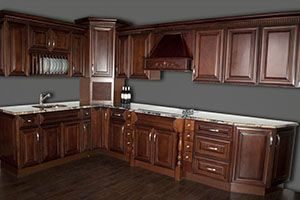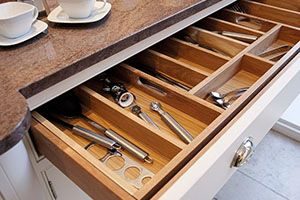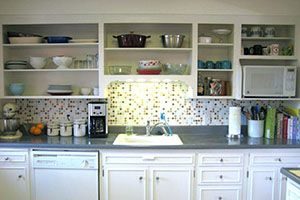When starting a kitchen remodel or simply updating your cabinetry, knowing which parts of the kitchen cabinet to focus on significantly improves the functionality and aesthetic appeal of your space. This guide highlights the crucial components of kitchen cabinets that deserve your attention, ensuring that every detail contributes to a well-designed and practical kitchen environment.
Table of Contents
ToggleCabinet Box and Frames

Material
You may not be aware that the boxes of modern kitchen cabinets are not usually all made of solid wood. The main box is usually plywood, medium-density fiberboard (MDF), or particleboard. Any solid wood is usually found only on the face frame, and none of it is a frameless cabinet. The panels usually have a wood veneer, lamination, or thermofoil cover.
In some instances, the box may be stainless steel. It is a novelty and a good choice for modern and industrial kitchens as it is very durable and does not have the problem of wood cabinets contracting and expanding with changes in the ambient temperature. You do have a problem with cleaning, as stainless steel picks up fingerprints quite easily.
Construction
The important point about the cabinet box and frame construction is the method of reinforcement to keep the shape of the box. This applies to cabinets that use wood or wood alternatives and not stainless steel. Several methods are in play, one of which is the use of triangular brackets placed in the corners. These brackets or braces may use plastic, solid wood, MDF, or particleboard.
The manufacturer may also choose a beam brace fitted in a dado slot (trench or housing) cut on the inner part of the side panels, running the length of the box from front to back or running along the back. Either method is effective for keeping the box rigid. What you do not want to see is the panels kept in place with adhesive, which keeps the wood from safely expanding and contracting.
Drawers

Drawers’ Material
Like cabinet boxes, drawers are mostly made of MDF, plywood, and particleboard, although you may find some more expensive varieties made of solid wood. This makes practical sense as drawers are subject to repeated closing and opening. Most drawer fronts are either MDF coated in thermofoil or solid wood. Some manufacturers also offer options to put stainless steel drawers for wood cabinets, disguising the material with an epoxy coat.
Drawer’s Construction
The construction of a drawer plays a big part in making it durable over time. The typical drawer has one bottom, front, and back panel plus two side panels and possibly an additional front piece that attaches to the front panel. Assembling the separate panels involves one of several methods. The strongest method is using dovetail joints that tightly join the drawer corners.
Another joinery method is by driving dowels down into matching holes to connect one panel to another. Trenches, housing, or dado slots may be cut into the bottom panels to accommodate the side panels, a much stronger method than gluing or nailing them together.
Cabinet Doors

Cabinet’s Material
Wood cabinet lines usually have solid wood cabinet doors, although engineered wood alternatives such as plywood, MDF, and particleboard covered in thermofoil, laminate, or veneer are also popular.MDF tends to be the most popular of these solid wood alternates because it is possible to cut, route, and finish MDF much as you would solid wood, while particleboard tends to fray and chip. The only thing you cannot do with MDF is stain it, as it has no grain, which is why it often has some type of surface cover or paint.
Cabinet’s Construction
Wood cabinet lines have doors that are either slab or framed. A framed door has separate panels to make up an outer frame and the center, which may or may not be a raised panel. When assembled, each panel fits into the appropriate slots cut along the inside of the frame with a bit of wiggle room to allow for expansion and contraction of the wood. This is referred to as floating panels.
Unlike framed doors, which have several panels that fit together without adhesive, slab doors are made of one solid piece of wood or engineered wood. The slab may actually be several pieces of wood joined by an adhesive to form a solid piece. If the slab is not solid wood, the lack of graining is hidden with a laminate, thermofoil, or veneer cover.
Cabinet Shelves

Cabinet Shelve Material
Most cabinet lines will make shelves from MDF, particleboard, or plywood. They typically have some type of laminate or wood veneer to make them easy to clean and protect core material. The shelf thickness may range from ½ to ¾ inches. Thicker shelves are better for wide cabinets to keep them from sagging.
Cabinet Shelve’s Construction
The most important aspect of cabinet shelf construction is reinforcement. Most cabinetmakers do not include a reinforcing strip or rail on the shelves of mass-produced cabinets. The rail is a strip of wood that runs the length of the front of the shelf, or about ½ inches deep on the underside of the shelf, all the way to both side panels.
This helps make the shelf more durable and minimize sagging. If you find them in your RTA or semi-custom cabinets, it is a sign of good quality construction. Of course, you can specify this feature for custom cabinets, and you should.
Conclusion
You don’t have to be an expert to choose good-quality kitchen cabinets. This general guideline gives you a good idea of what you need to pay attention to. It also helps if you find a reliable supplier and work closely with them.
Cabinet Land Kitchen and Beyond works only with the best cabinet brands at the best prices compared to our competitors, such as Advance Cabinets and Handsome Cabinets. We also offer better free consultation services and quotes, so you know exactly what to expect from your purchase.



